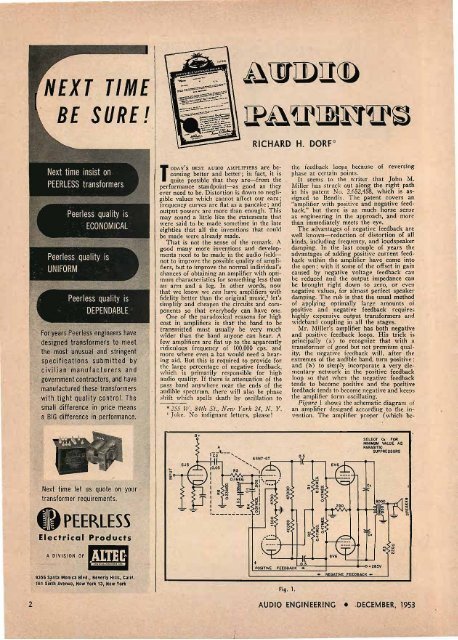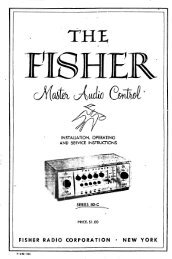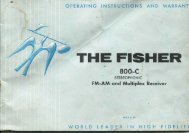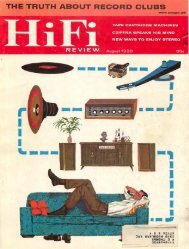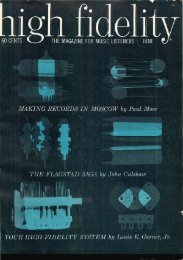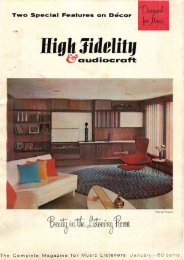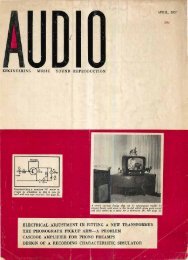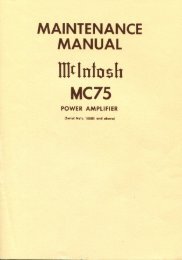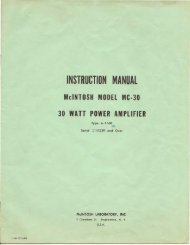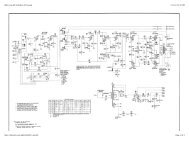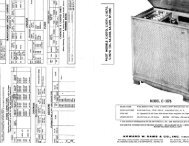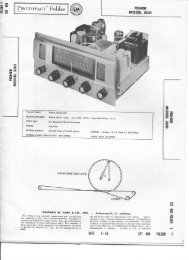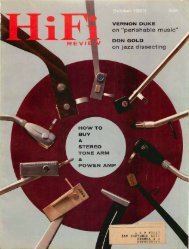anywhere
Audio Enginnering magazine December 1953 - Vintage Vacuum ...
Audio Enginnering magazine December 1953 - Vintage Vacuum ...
- No tags were found...
Create successful ePaper yourself
Turn your PDF publications into a flip-book with our unique Google optimized e-Paper software.
NEXT TIME<br />
BE SURE!<br />
Foo!ears Peerless engineers have<br />
.. ~.: ~ I; ~ .<br />
designed transformers to meet<br />
the most unusual and stringent<br />
sp ec ificat io ns subm itte d by<br />
c i v II ian man u f a cf u r e r san d<br />
government contractors, and have<br />
manufactured these transformers<br />
with tight quality cont rol. .The<br />
small difference in price means<br />
a BIG difference in performance.<br />
T<br />
ODAv'S BEST AUDIO AMPLIFIERS are becoming<br />
better and better; in fact, it is<br />
quite possible that they are-from the<br />
performance standpoint-as good as they<br />
ever need to be. Distortion is down to negligible<br />
values which cannot affect our ears;<br />
frequency curves are flat as a pancake; and<br />
output powers are more than enough. This<br />
may sound a little like the statements that<br />
were said to be made sometime in the late<br />
eighties that all the inventions that could<br />
be made were already made.<br />
That is not the sense of the remark. A<br />
good many more inventions and developments<br />
need to be made in the audio fieldnot<br />
to improve the possible quality of amplifiers,<br />
but to improve the normal individual's<br />
chances of obtaining an amplifier with optimum<br />
characteristics for something less than<br />
an arm and a leg. In other words, now<br />
that we know we can have amplifiers with<br />
fidelity better than the original music,' let's<br />
simplify and cheapen the circuits and components<br />
so that everybody can have one.<br />
One of the paradoxical reasons for high<br />
cost in amplifiers is that· the band to be<br />
transmitted must usually be very much<br />
wider than the band anyone can hear. A<br />
few amplifiers are flat up to the apparently<br />
ridiculous frequency of 100,000 cps. and<br />
more where even a bat would need a hearing<br />
aid. But this is required to provide for<br />
the large percentage of negative feedback,<br />
which is primarily responsible for high<br />
audio quality. If there is attenuation of the<br />
pass band <strong>anywhere</strong> near the ends of the<br />
audible spectrum, there will also be phase<br />
shift which spells death by oscillation to<br />
* 255 W. 84th St., New York 24 N. Y.<br />
1 Joke. No indignant letters, ple'ase!<br />
RICHARD H. DORP<br />
the feedback loops because of reversing<br />
phase at certain points.<br />
It seems to the writer that John M.<br />
Miller has struck out along the right path<br />
in his patent No. 2,652,458, which is assigned<br />
to Bendix. The patent covers an<br />
"amplifier with positive and negative feedback,"<br />
but there is as much horse sense<br />
as engineering in the approach, and more<br />
than immediately meets the eye.<br />
The advantages of negative feedback are<br />
well known-reduction of distortion of all<br />
kinds, including frequency, and ioudspeaker<br />
damping. In the last couple of years the<br />
advantages of adding positive current feedback<br />
wi thin the amplifier have come into<br />
the open; with it some of the offset in gain<br />
caused by negative voltage feedback can<br />
be reduced and the output impedance can<br />
be brought right down to zero, or even<br />
negative values, for almost perfect speaker<br />
damping. The rub is that the usual method<br />
of applying optimally large amounts of<br />
positive and negative feedback requires<br />
highly expensive output transformers and<br />
wideband coupling in all the stages.<br />
Mr. Miller's amplifier has both negative<br />
and positive feedback loops. His trick is<br />
principally (a) to recognize that with a<br />
transformer of good but not premium quality,<br />
the negative feedback wilJ, after the<br />
extremes of the audible band, turn positive :<br />
and (0) to simply incorporate a very elementary<br />
network in the positive feedback<br />
loop so that when the negative feedback<br />
tends to become positive and the positive<br />
feedback tends to become negative and keeps<br />
the amplifier form oscil1ating.<br />
Figure 1 shows the schematic diagram of<br />
an amplifier designed according to the invention.<br />
The amplifier proper (which be-<br />
0 .3<br />
SELECT Cx FOR<br />
MINIMUM VALUE AS<br />
PARASITIC<br />
.SUPPRESSORS<br />
Next time let us quote on your<br />
transformer requirements.<br />
_PEERLESS<br />
Electrical<br />
,"''''''"<br />
Products<br />
'~Uilt<br />
9356 .S!lnta Monica Blvd., Beverly Hills, Calif.<br />
161 Sixth Avenue, New York 13, New York<br />
1<br />
.-----...:.----<br />
·POSITIVE<br />
FEEOBACK,--,:;~;=.3_-4----+--o+2B5V<br />
Fig. 1.<br />
NEGATIVE FEEDBACK ..<br />
o<br />
'" 0<br />
'" '"<br />
2<br />
AUDIO ENGINEERING • . DECEMBER, 1953


